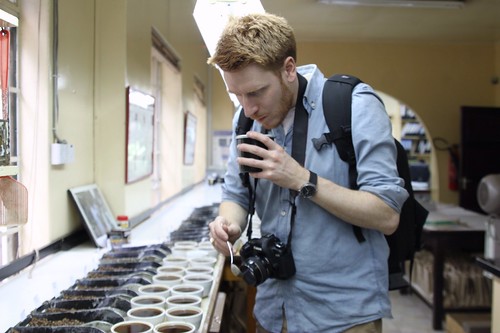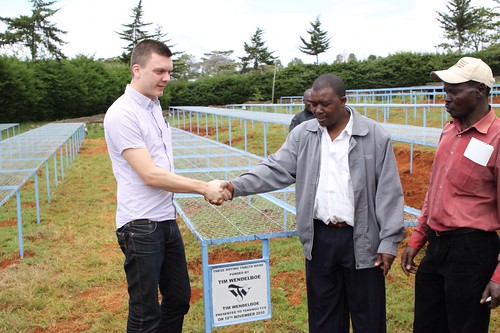Tim and I have already spent 6 days in Kenya together with our dear friend and customer Anders Valde (the first World Aeropress Champion) and our good friend and coffee colleague from Solberg & Hansen, Alexander Scheen Jensen.
Our trip started on Monday where we spent the day at Dorman’s cupping lab, tasting the freshly harvested coffee from the fly crop in Kenya, followed by a tour at their green coffee mill and roasting factory in Nairobi. Although one of the coffees had already been sold for over USD 7 per lb. None of the coffees were spectacular.
On Tuesday we visited CMS (Coffee Management Servives) in Ruiru. CMS is both a marketing agent and a technical and agriculture resource for the cooperatives we buy from . The manager of CMS, Mr. Kamau Kuria has personally been in charge of making sure the money we donated through our drying table project was spent in the best possible way. We were lucky to have a one hour meeting with the ever busy Mr. Kamau, and he gave us vital info about the current harvest and the prognosis of next years coffee production in Kenya.
To sum up what he said; the severe rains during the flowering period has lead to less flowering making yields about 40% less than last years crop, which was also very low. The current prognosis of total production in the main harvest this year is only at 34.000 metric tons. However, the amount of AA and elephant beans is much higher due to a lot of rain during the expansion phase of the coffee cherries. This means there will be a lot of good quality coffee coming out of Kenya, but the yields are unfortunately very low, so there will be a lot of fighting and high prices to expect for the best lots.
In the afternoon we headed for Nyeri which was our main destination for this trip.
Wednesday morning we got a brief tour of the Central Kenya Coffee Mill where all our coffees are being dry milled before export.
After the tour we went to visit the Tekangu Cooperative Society and to finally do the official hand over of the drying tables we have funded through our drying table project on our 3 year anniversary. The board of directors greeted us with coffee and sweet potato complimented with good conversation. As this was my 3rd time visiting it was great to listen to the improvements done and future plans they had made to develop the coffee quality and infrastructure on their factories. The coffee we bought from Tekangu this year came from the Karogoto factory, so we had decided to place the new drying tables there.
As we went up to see the new tables, i was stunned and a bit shocked when the tables revealed themselves behind a row of trees protecting the Karogoto factory. Not only had CMS (Coffee Management Services) managed to build 8 new tables for the money we donated, but the tables were huge and the quality was extremely good.
Here are the most important features of the new tables:
- Galvanized steel net to prevent rust hence a longer lasting drying surface.
- Ergonomic height of the table to make it easier for workers as they don’t need to bend over to work on the drying coffee.
- Extra steel wire for better support of the drying surface to prevent the net from sagging.
- Concrete fundaments to prevent the tables to sink into the ground.
- Angled edges at the end of the table to prevent workers from sitting on them as then they will more easily get ruined.
- Each table can dry 20 bags which is 1 metric ton of coffee. They can dry 8 tons at the same time with the 8 tables.
Normally the Tekangu cooperative would spend 10 to 12 years to build 8 new steel drying tables, so the board members of Tekangu and especially the production manager of the Karogoto factory were very happy for the donation of the new tables.
The vice chairman of Tekangu made me promise to thank all our customers in Norway and C. Dorman in Kenya who supported the project and made it possible to build these drying tables. I am also extremely happy to see that the project went so well, so a big thank you to all who supported it.
The best part of the whole project is that the factory manager at Karogoto promised us he will separate the coffee that gets dried on the new tables so that we will be able to taste the difference between the coffee dried on the new vs old tables. I can’t wait to taste the difference when I go back to Kenya in February and hopefully we will be able to buy the coffee if the quality is as expected.
Of course our trip did not end there. We have also done a lot of other great stuff down here in Kenya, but I will write about that in part 2 of this post next week. (some key topics for the next post: new varietal (Batian) released in Kenya, pictures of enormous Liberica and Excelsa coffee trees, cupping of different grades in Kenya, etc)




